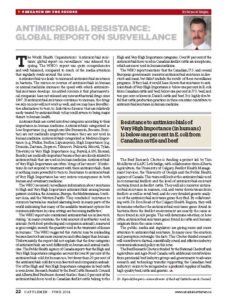Antimicrobial Resistance: Global Report on Surveillance
This article written by Dr. Reynold Bergen, BCRC Science Director, originally appeared in the June 2014 issue of Canadian Cattlemen magazine and is reprinted on the BCRC Blog with permission of the publisher.
Remarque : cette page web n’est actuellement disponible qu’en anglais.

The World Health Organization’s “Antimicrobial resistance: global report on surveillance” was released this spring. The WHO’s report was quite comprehensive and well-balanced, compared to much of the media attention that regularly swirls around this issue.
Antimicrobial use leads to increased antimicrobial resistance in bacteria. The misuse or overuse of antimicrobials in human or animal medicine increases the speed with which antimicrobial resistance develops. An added concern is that pharmaceutical companies have not released any new antibacterial drugs since 1987. If antimicrobial resistance continues to increase, the drugs we rely on now will not work as well, and we may have few effective alternatives to turn to. Infectious diseases that are relatively easily treated by antimicrobials today could return to being major threats to human health.
Antimicrobials are sorted into four categories according to their importance in human medicine. Antimicrobials categorized as Low Importance (e.g. ionophores like Rumensin, Bovatec, Posistac) are not medically important because they are not used in human medicine. Antimicrobials categorized as Medium Importance (e.g. Nuflor, Resflor, Liquamycin), High Importance (e.g. Draxxin, Zactran, Zuprevo, Tilmovet, Pulmotil, Micotil, Tylan, Trivetrin) or Very High Importance (e.g. Baytril, A180, Excenel, Excede) are medically important because they are closely related to antimicrobials that are used in human medicine. Antimicrobials of Very High Importance are often “drugs of last resort”. If infections do not respond to treatment with these antimicrobials, there is nothing more powerful to turn to. Resistance to antimicrobials of Very High Importance has very serious consequences in both human and veterinary medicine.
The WHO reviewed surveillance information about resistance to High and Very High Importance antimicrobials among human patients in Africa, the Americas, Europe, the Mediterranean, Southeast Asia, and the Western Pacific. They concluded “resistance to common bacteria has reached alarming levels in many parts of the world indicating that many of the available treatment options for common infections in some settings are becoming ineffective.”
The WHO report also mentioned antimicrobial use in livestock, stating, “in many countries, the total amount of antibiotics used in animals (both food-producing and companion animals), measured as gross weight, exceeds the quantity used in the treatment of disease in humans.” The WHO suggested this statistic may be misleading because livestock are more numerous and often larger than humans. Unfortunately, the report did not explain that the four categories of antimicrobials are used differently in human and animal medicine.
The Public Health Agency of Canada reports that the High and Very High Importance categories account for over 80% of the antimicrobials sold for human use, but fewer than 20% of the antimicrobials sold for use in livestock and companion animals. Use of the High and Very High Importance categories in beef cattle is even lower. Research funded by the Beef Cattle Research Council and Alberta Beef Producers showed that less than 1% of the antimicrobial doses used in Canadian feedlot cattle belong to the High and Very High Importance categories. Over 90% of the antimicrobial doses used in Canadian feedlot cattle are ionophores, which are never used in human medicine.
The WHO report mentions that the Canadian, US, and several European governments monitor antimicrobial resistance in livestock and meat, but didn’t include the results of these surveillance programs. If they had, it would have shown that resistance to antimicrobials of Very High Importance is below 1% in E. coli from Canadian cattle and beef, below 1% in US beef, and 2% or lower in Danish cattle and beef. It is highly doubtful that cattle production practices in these countries contribute to antimicrobial resistance in human medicine.
The Beef Research Cluster is funding a project led by Tim McAllister of AAFC Lethbridge, with collaborators from Alberta Agriculture, the University of Calgary, Feedlot Health Management Services, the University of Guelph and the Public Health Agency of Canada. This team will look at the antimicrobials used in commercial feedlots and the level of antimicrobial resistant bacteria found in feedlot cattle. They will also monitor antimicrobial resistance in manure, soil, and water downstream from feedlots as well as retail beef, and do very detailed genetic analyses of the antimicrobial resistance genes they find. By collaborating with Dr. Ron Read of the Calgary Health Region, they will determine whether the antimicrobial resistance genes found in bacteria from the feedlot environment are exactly the same as those found in sick people. This will determine whether or how often antimicrobial resistance genes found in cattle and humans originate from the same source.
The public, media and regulators are giving more and more attention to antimicrobial resistance. In many cases the emotion and perception outweighs the facts. This Cluster-funded research will contribute to factual, scientifically sound and effective industry communication and policy on this issue.
Click here to subscribe to the BCRC Blog and receive email notifications when new content is posted.
The sharing or reprinting of BCRC Blog articles is typically welcome and encouraged, however this article requires permission of the original publisher.
We welcome your questions, comments and suggestions. Contact us directly or generate public discussion by posting your thoughts below.